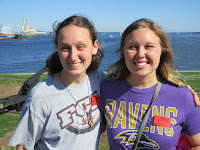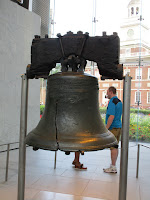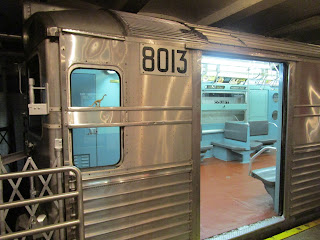Growing up, my mom made me a promise. She was a French teacher, and a linguist. She promised me that if I took French, starting in Kindergarten, and stuck with it all the way through grade school, she would take me to France.
Parents, be careful what you promise your children. I did this, and have attempted to at least stay familiar with the language through reading since I graduated high school. It's ended up being useful; while most scientific journals that I need are in English, I've run into several that have been in French that I've needed to read.
Sure enough, after the first year of my master's, we got around to taking that trip. Now, we've both been out of practice for so long at this point that speaking was REALLY hard (especially for me!) But after a couple of days we were at least able to make ourselves understood. We visited a beautiful island abbey, the Dordogne valley (an area famous for its early human remains and cave paintings), and Paris.

 On one of the first days that we were exploring the countryside, we went to Mt. St. Michel. It is a beautiful little abbey on an island with gorgeous architecture and a rich history. As I said, we've both been a bit out of practice for a while now, so we ended up choosing to take the English tour. My science French vocabulary? Pretty good. My history and architecture vocab? Um.... not.... not good. It turned out to be a good decision. However, these weren't English speakers who just decided to come and work at a historic site in France. These were French speakers who were better English speakers than I could even hope for my foreign language skills to be. And I am very, very thankful to the folks that we met for either helping us learn new words or speaking English when we were really lost. But it was this tour where I ran into an odd translation that would follow me for the remainder of the trip, and brought up something that I will continue to keep in mind as non-English speakers visit places I work.
On one of the first days that we were exploring the countryside, we went to Mt. St. Michel. It is a beautiful little abbey on an island with gorgeous architecture and a rich history. As I said, we've both been a bit out of practice for a while now, so we ended up choosing to take the English tour. My science French vocabulary? Pretty good. My history and architecture vocab? Um.... not.... not good. It turned out to be a good decision. However, these weren't English speakers who just decided to come and work at a historic site in France. These were French speakers who were better English speakers than I could even hope for my foreign language skills to be. And I am very, very thankful to the folks that we met for either helping us learn new words or speaking English when we were really lost. But it was this tour where I ran into an odd translation that would follow me for the remainder of the trip, and brought up something that I will continue to keep in mind as non-English speakers visit places I work.
The tour guide began explaining the origin of letters carved into bricks that were outside the abbey. They were written by the people making the bricks, and used to keep track of which workers made how many. This was related to how much they would be paid. However, he kept referring to the letters as "tracks."
 Alright. I could see someone calling these tracks in a English, at least in a somewhat sense. He wasn't wrong, it just caught me off guard. I didn't think anything of it until we continued into the abbey and he repeatedly used the word referring to carvings, maker's marks, tool marks, and the masonry that kept the stones together for so many centuries. Again, none of the ways that he used the word were technically wrong, but it isn't the first word that I would've thought to use. So that evening, we looked up the word for "track" in French. My guess was that the word used for track had a broader meaning in French than it does in English.
Alright. I could see someone calling these tracks in a English, at least in a somewhat sense. He wasn't wrong, it just caught me off guard. I didn't think anything of it until we continued into the abbey and he repeatedly used the word referring to carvings, maker's marks, tool marks, and the masonry that kept the stones together for so many centuries. Again, none of the ways that he used the word were technically wrong, but it isn't the first word that I would've thought to use. So that evening, we looked up the word for "track" in French. My guess was that the word used for track had a broader meaning in French than it does in English.
If you have ever taken a foreign language course, you know that simply plugging what you want to say in a translating tool won't get you the best grade.
Oh, it might give you a useful word. But it also may conjugate that one verb wrong, put those words in the wrong order, or even give you a different vocabulary word than your teacher intended for you to use. Other than the fact that programming computers to properly account for grammatical correctness in a single language is complicated, translations are almost never cut and dry. There's one reason right there already. Idioms, colloquial phrases, and imagery are not always shared between cultures. In addition, words almost never translate directly and simply.
This isn't uncommon. What a single word may be able to represent in our language may require more specificity in another language, and what many words may represent in our language with slightly varying connotations may be the same, single word in that same other language.
The word that means "track" in French is "une empreinte." And while "tracks" is one meaning, and the most direct translation of it, it can also have the connotation of trace, print (as in tracks or finger prints), impression, cast, step, mark, step... you get the idea. So it was no surprise that we continued to see this word elsewhere.
 I saw it at cave art sites, where it referred to "traces" of people, as well as when cut marks made by people in bones were involved. It showed up in Paris at an exhibit about dinosaurs in reference to both trackways and skin impressions. It was used at multiple museums in reference to impressions (or compressions) of leaves and invertebrates.
I saw it at cave art sites, where it referred to "traces" of people, as well as when cut marks made by people in bones were involved. It showed up in Paris at an exhibit about dinosaurs in reference to both trackways and skin impressions. It was used at multiple museums in reference to impressions (or compressions) of leaves and invertebrates.
And, of course, it was in an exhibit about trackways in caves. However, this exhibit was not only about "tracks." It was about trace fossils in general, and included the impressions of rain drops. So apparently "une empreinte" can also refer to trace fossils in general.
To further complicate matters, the verb form of the word, "empreindre," can mean to mark, to leave a print.... etc...
However, the word "une empriente" does not ever translate to tracks as in "train tracks." It more closely reflects the meaning of "trace."
Moral of the story? Language and culture further complicate the communication of science, and should be kept in mind. However, seeing how scientists in other countries use language can give us a window into how others understand science, and sometimes offers us another way to see the world.



















































